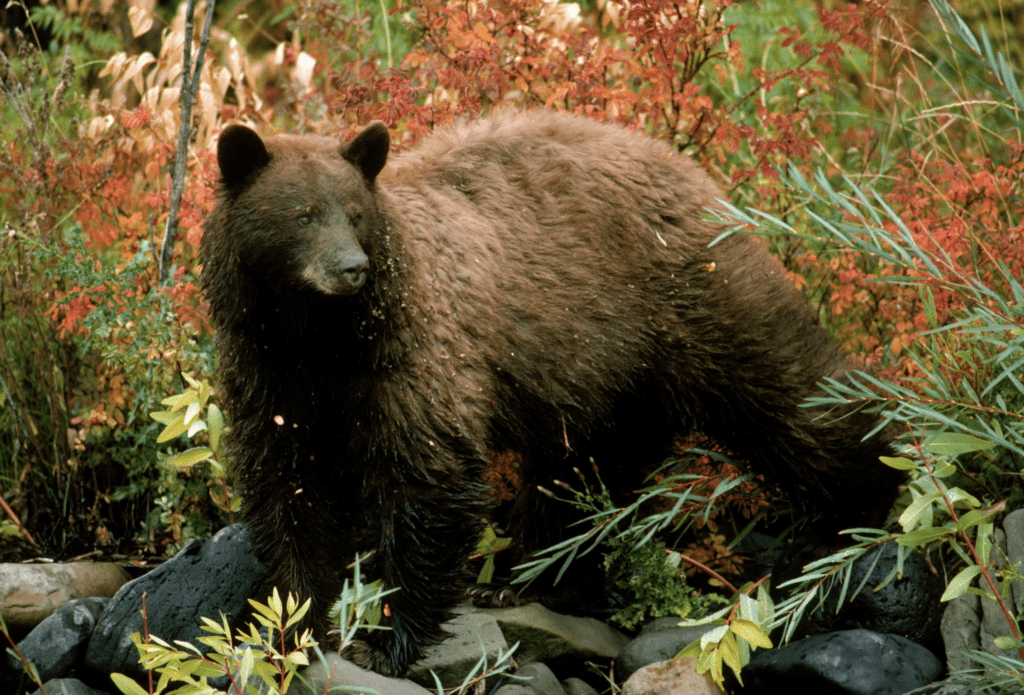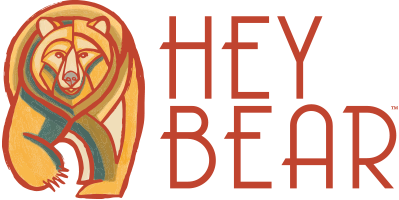Hey Bear: Why we yell it in bear country

Hey Bear is more than a brand; it is a movement!
By Mira Brody VP MEDIA
This column is presented in partnership with Hey Bear, a retail brand based in Big Sky focused on grizzly bear conservation and awareness. If you have a story about a bear encounter or interaction in the Greater Yellowstone Ecosystem, please submit via email to media@outlaw.partners.
This article was originally published in the Winter 2021/22 issue of Mountain Outlaw.
When Nate Bender goes camping or hiking, he makes it a habit to keep his bear spray to his right side—on the right-hand pocket of his backpack or to the right of his sleeping bag at night. On July 4, 2021, that habit came in handy for the first time. It may have even saved a few lives.
An avid outdoorsman and native of Hamilton, Montana, Bender grew up recreating in bear country with his family and continues to do so from his home in Missoula where he is attending the University of Montana for dual graduate degrees in research conservation and business analytics. This summer, he was camping alone, what he calls “cowboy style,” in the Mission Mountains when sounds of a bear growling woke him around 6 a.m.
“I can think of better ways of being woken up,” Bender said. “It all happened very quickly. When I opened my eyes after that sound I was looking right at the mama and her two cubs.”
The sow bear, which Bender identified as a grizzly, charged within five seconds, just enough time for him to reach to his right, grab his bear spray, pull off the safety and deploy a 30-foot pepper spray cloud that deterred her and may have saved both their lives.


Bear encounters are not only dangerous to humans but put bears at risk as well. Over Labor Day weekend in 2021, four grizzlies—a sow and her three cubs—were euthanized after improperly stored food habituated the bears into breaking into vehicles and residences. The sow had been a longtime resident of Glacier National Park and is said to have mothered at least 10 cubs over the years.
Bender did everything right: he stored his food away from camp in a scent-proof and bear-proof bag and had bear spray on hand, within reach, and ready to deploy at a moment’s notice; and he had practiced with his spray. He calls the encounter a combination of preparation and luck but asserts that everyone entering bear country should do so with a visitor’s mindset—you are entering a wild habitat in which wild animals live and thrive.
“Following these recommendations and being ‘bear aware’ adds layers of safety for people, but they also help keep bears wild,” said Morgan Jacobsen, Region 3 information and education program manager for Montana Fish, Wildlife and Parks.
Bears that are habituated to gaining access to food, whether it be garbage, pet food, bird feeders or other attractants, according to Jacobsen, lose their natural drive to find food in the wild and oftentimes cannot be rehabilitated. “Keeping attractants secured not only helps keep you and your neighbors safe, it helps keep bears alive and promotes healthy bear behavior.”
Yellowstone National Park visitation numbers broke all-time records in both July and August of 2021, and Gallatin Valley is the fastest growing micropolis in the country. As more people visit and move to these wild areas, bear encounters will become more common. In addition to storing food properly, hiking in groups, and carrying and knowing how to use bear spray, it’s also key to avoid startling bears, which many people do by yelling “Hey bear!”
The brand Hey Bear has harnessed the power of these words and turned it into a movement.
“There’s been this massive population growth in bear habitat areas,” said Eric Ladd, the brand’s founder and owner of Outlaw Partners, publisher of Mountain Outlaw. “You see more and more interactions with people and bears … and it prompted me to try and have an impact and create a solution for these problems.”
Hey Bear cobrands with a number of sustainable and ethical brands, such as Cotopaxi, selling T-shirts, hats, jackets and bear spray belts, and is subsequently creating a movement around education and recreation as well as partnering with regional bear habitat conservation efforts. Hey Bear is more than just a brand of sustainable and fashionable products—it’s a movement that advocates for those beautiful apex predators with whom we live.
This is the ethos of Hey Bear.
“If you’re going to coexist with a creature at the top of a the predator pile, like a bear, you have to treat them with a tremendous amount of care and respect, otherwise that interface is not going to turn out well,” said Ladd. “We should consider ourselves lucky to be stewards and to be living with a creature such as a bear.”
And we are lucky—lucky to share a space in this beautiful ecosystem with these bruins. Lucky, even, to be awakened by them at night while camping, or to see one on a hike or from a distance in our car so long as we’ve taken the precautions required of us to be good stewards in their home.
Tips from Montana Fish, Wildlife and Parks
Being responsible in bear country
- Hike in groups of three or more
- Make noise, we recommend shouting “Hey bear!”
- Store food properly when hiking or camping
- Carry bear spray, keep it within reach ad know how to use it
- Visiting ab ear safety class with Fish, Wildlife and Parks
- If you see a bear from afar, stay 100 yards away
- If you encounter a bear and it moves toward you, move slowly away and speak in low tones
- If a black bear charges, stand your ground and fight back
- If a grizzly charges, lay flat on your stomach, protecting your neck and head with your arms and do not move
- NEVER run from a bear



